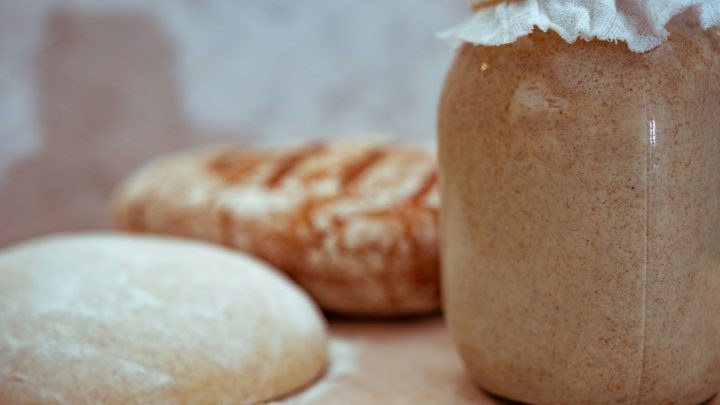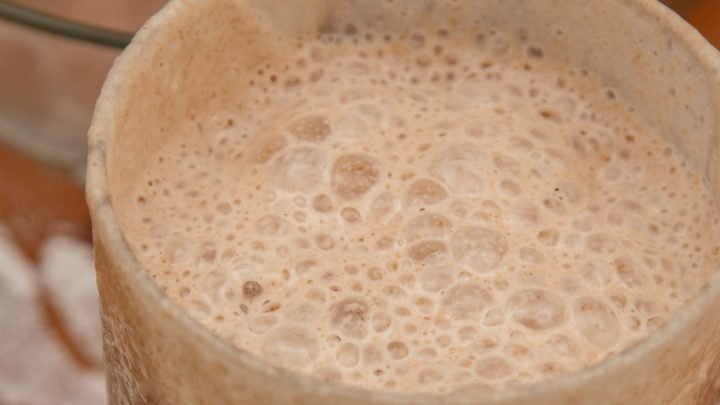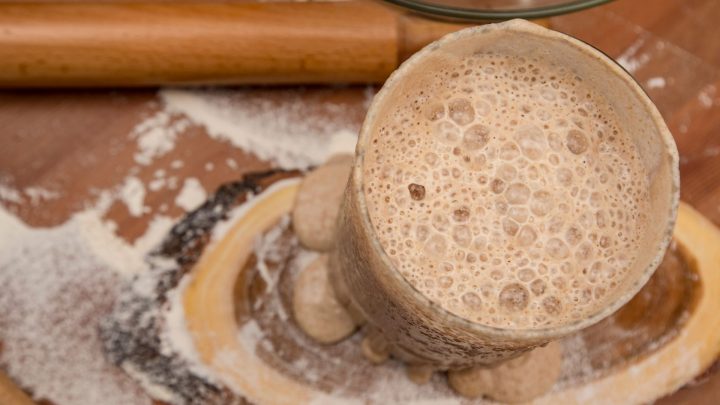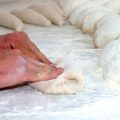Curious about the shelf life of sourdough discard? Look no further! In this short guide, we’ll explore the question of how long you can keep sourdough discard and provide some insights. Sourdough discard refers to the portion of sourdough starter that is removed during the feeding process. While it may not be suitable for baking, it still holds potential for various culinary creations. However, it’s essential to understand how long sourdough discard can be safely stored before its quality begins to deteriorate. Stay tuned as we uncover the answers and share tips for maximizing the use of your sourdough discard.

Table of Contents
- How Long Can I Keep Sourdough Starter Discard?
- Can You Use Old Sourdough Discard?
- Does Sourdough Discard Need To Be Refrigerated?
- Does Sourdough Discard Spoil?
- What Is Sourdough Discard?
- Sourdough Discard – Seal and Store that Discard Jar!
- FAQs
How Long Can I Keep Sourdough Starter Discard?
Sourdough starter discard can be stored in the refrigerator for up to a week, provided it has been properly maintained and fed regularly prior to being discarded. This timeframe is a general guideline, and the discard can still be viable beyond a week if it shows no signs of spoilage or off odors.
However, keep in mind that the longer the discard is stored, the less active it becomes, resulting in reduced leavening power. If you plan to use the discard for baking, it’s best to use it within the first few days when it is still relatively active.
Remember to give the discard a stir before using it, as the liquid and solids may separate during storage.
Can You Use Old Sourdough Discard?
Yes. While sourdough discard can lose some of its leavening power and activity over time, it can still be used in certain recipes even if it’s considered “old.”
Here are a few considerations:
- Flavor-enhancing recipes: Discard can still contribute its distinct tangy flavor to recipes even if its leavening power has diminished. Recipes like pancakes, waffles, muffins, and crackers rely more on flavor than rise, making them suitable for using older discard.
- Combination with other leavening agents: If you’re using older sourdough discard in recipes that require leavening, such as bread or certain pastries, you can enhance its effectiveness by adding a small amount of commercial yeast, baking powder, or baking soda. This helps compensate for the reduced leavening power of the old discard.
- Smaller proportion of discard: When using older discard, you may want to increase the proportion of fresh flour or other leavening agents in your recipe to ensure adequate rise.
- Trial and error: Experimentation is key when using older discard. Different starters and storage conditions can affect the activity and viability of the discard. It’s best to test a small batch of your desired recipe to gauge the results before committing to a larger batch.
While older sourdough discard may not perform as well as fresh starter, it can still add flavor and contribute to certain recipes. With a bit of creativity and adaptation, you can find ways to utilize your older discarded starter effectively.
Does Sourdough Discard Need To Be Refrigerated?
Yes, sourdough discard should be refrigerated to maintain its quality and slow down fermentation. The cold temperature of the refrigerator helps to inhibit the growth of unwanted bacteria and yeast in the discard, keeping it stable for a longer period.
When not actively using or feeding your sourdough starter, it’s recommended to store it in the refrigerator. This includes the sourdough discard that is removed during the feeding process.
Before refrigeration, make sure the sourdough discard is covered or stored in an airtight container. This will prevent fresh sourdough discard from drying out or absorbing odors from other food items in the refrigerator.
Refrigerating the sourdough discard allows it to stay viable for up to a week, giving you ample time to use it in various culinary creations. Remember to stir the discard before using it, as separation of liquid and solids may occur during storage.
Does Sourdough Discard Spoil?
Sourdough discard can spoil if not stored or handled properly.
While the acidic environment of sourdough helps prevent harmful bacterial growth, there are factors to consider. Mold growth can occur if discard is exposed to excess moisture or mold spores. Off odors and unpleasant smells are signs of spoilage, as well as significant changes in color.
To prevent spoilage, store discard in the refrigerator in an airtight container, practicing proper hygiene. Regularly inspect the discard before use. When in doubt, discard it to avoid potential health risks. Proper storage and vigilance can help maintain the quality and safety of your sourdough discard.

What Is Sourdough Discard?
Sourdough discard refers to the portion of sourdough starter that is removed or “discarded” during the feeding process.
When maintaining a sourdough starter, it needs regular feedings of flour and water to keep it active and healthy. During these feedings, a portion of the mature starter is usually removed to make room for fresh flour and water. This removed portion, known as sourdough discard, is typically set aside for alternative culinary uses instead of being discarded entirely.
While it may not be suitable for baking bread due to its lower leavening power, sourdough discard can be used in a variety of recipes like pancakes, waffles, crackers, and more, adding a delightful tang and flavor to your creations.
How To Use a Discard In A Recipe?
Using sourdough discard in recipes is a great way to minimize waste and add flavor to your dishes.
Here’s a general guide on how to incorporate sourdough discard into recipes:
- Find compatible recipes: Look for recipes specifically designed to use sourdough discard. These can include pancakes, waffles, muffins, crackers, breads, pizza dough, or even certain cakes and cookies. These recipes are formulated to make the most of the discard’s flavor and texture.
- Adjust the ratios: Most recipes that call for sourdough discard will specify the amount needed. If the recipe doesn’t provide exact measurements, you can typically substitute some or all of the liquid or flour components with an equal amount of discard. Adjusting the ratios may require a bit of experimentation to achieve the desired consistency and flavor.
- Consider leavening agents: Depending on the recipe and the age of your discard, you may need to supplement it with additional leavening agents such as baking powder, baking soda, or commercial yeast to ensure proper rise and texture. Follow the recipe instructions and consider the specific needs of each recipe.
- Flavor adjustments: Sourdough discard adds a tangy flavor, so take this into account when adjusting the other flavors in your recipe. You may need to tweak the amount of sugar, salt, or other ingredients to achieve the desired balance.
- Follow recipe instructions: Once you’ve chosen a recipe and made the necessary adjustments, follow the instructions as provided. Incorporate the sourdough discard at the appropriate step, mixing it in thoroughly with the other ingredients.

How To Reduce Your Sourdough Discard
Reducing sourdough discard is a smart way to minimize waste and make the most of your sourdough baking.
Here are a few tips to help you reduce your sourdough discard:
- Adjust feeding schedule: Instead of maintaining a large starter, consider reducing the quantity by feeding it less frequently or in smaller amounts. This will result in less discard generated during feedings.
- Use smaller starter quantities: Scale down your starter size for feedings. By reducing the initial amount of starter, you’ll generate less discard.
- Plan your baking: Plan your baking schedule to coincide with your starter’s feeding schedule. Use the starter at its peak activity to bake bread or other sourdough creations, minimizing the amount of discard.
- Explore discard recipes: Look for recipes that specifically call for sourdough discard, such as pancakes, waffles, crackers, or even incorporating it into soups or stews. These recipes allow you to use up your discard effectively.
- Share or gift discard: If you find yourself with excess discard, consider sharing it with friends, family, or fellow baking enthusiasts. They can use it to kick-start their own sourdough journeys.
Sourdough Discard – Seal and Store that Discard Jar!
Your sourdough discard can be stored in the refrigerator for up to a week, while still maintaining its usability. You can even use your sourdough starter discard straight from the fridge, should you wish to bake something with it on the day. Freeze sourdough discard if you wish to store it for longer.
However, it’s essential to monitor for signs of spoilage such as mold growth, off odors, or significant color changes. Proper storage and regular inspections ensure the discard remains safe and suitable for culinary creations.
Ready to bake? Check out my many sourdough discard recipe options on the blog!
FAQs
Can You Keep Sourdough Starter Discard In The Fridge?
Yes, you can keep sourdough starter discard in the fridge. It’s a common practice to store discard in the refrigerator between feedings or when not actively using it. The cold temperature slows down fermentation and reduces the need for frequent feeding. Just make sure to cover it properly to prevent drying out or absorbing odors.
How To Dispose of Your Sourdough Discard?
When disposing of sourdough discard, it’s important to avoid pouring it down the sink or toilet, as it can cause plumbing issues. Instead, consider using it in recipes like pancakes, waffles, or crackers. Alternatively, you can compost it or offer it to others who might be interested in using it as a starter.
How do You Know if Sourdough Discard is Bad?
Watch out for unusual colors, smells, and growths. If you did not store sourdough discard properly (refrigerated or frozen), it is likely to be spoiled if kept out at an indefinite period of time. Do not use to bake sourdough bread, just chuck it away!
Can You Add Old Sourdough Discard to New Sourdough Starter?
Yes, you can add discard that is old to a new batch of healthy starter. By adding fresh discard to the old, you introduce beneficial microorganisms that can contribute to the flavor and strength of your sourdough culture. It’s an excellent way to reduce waste and utilize the previous batch of discard..





